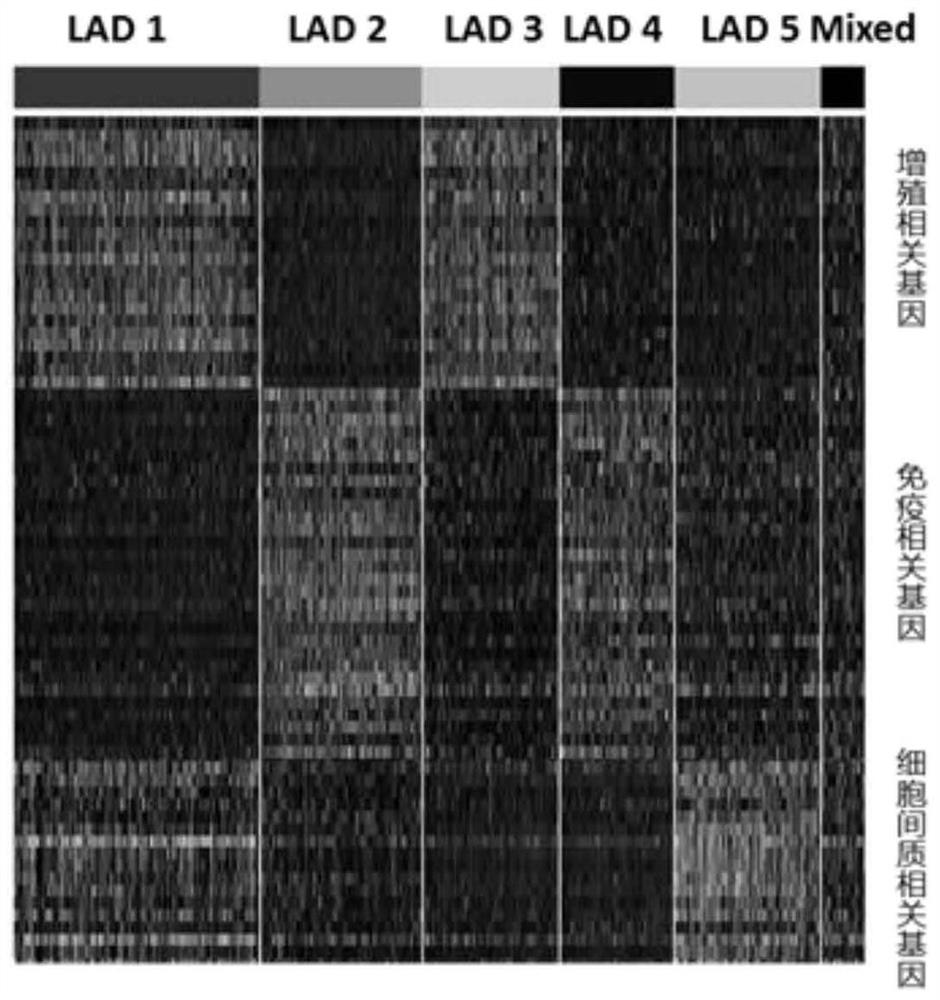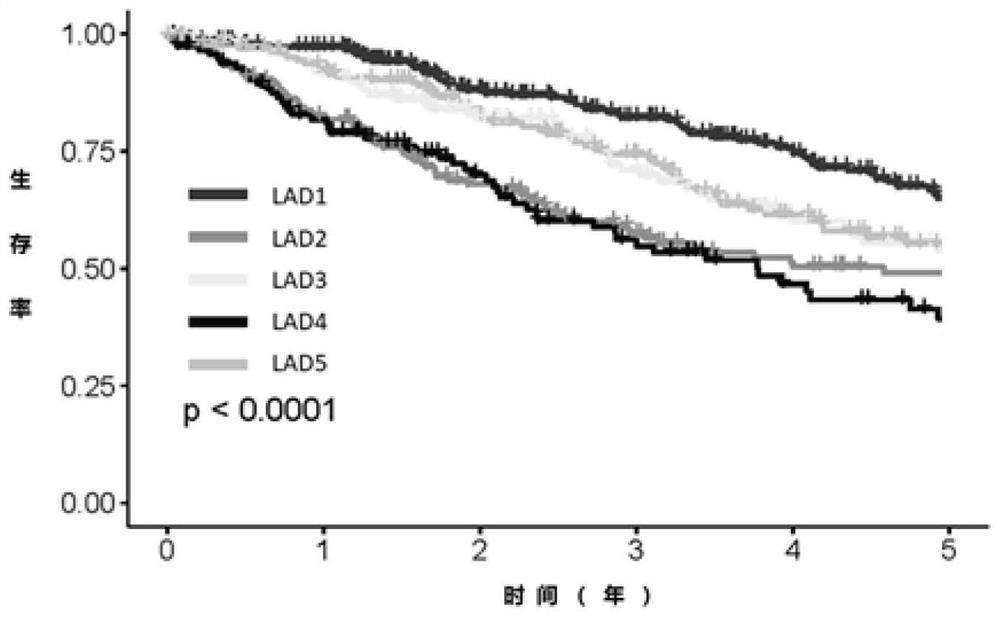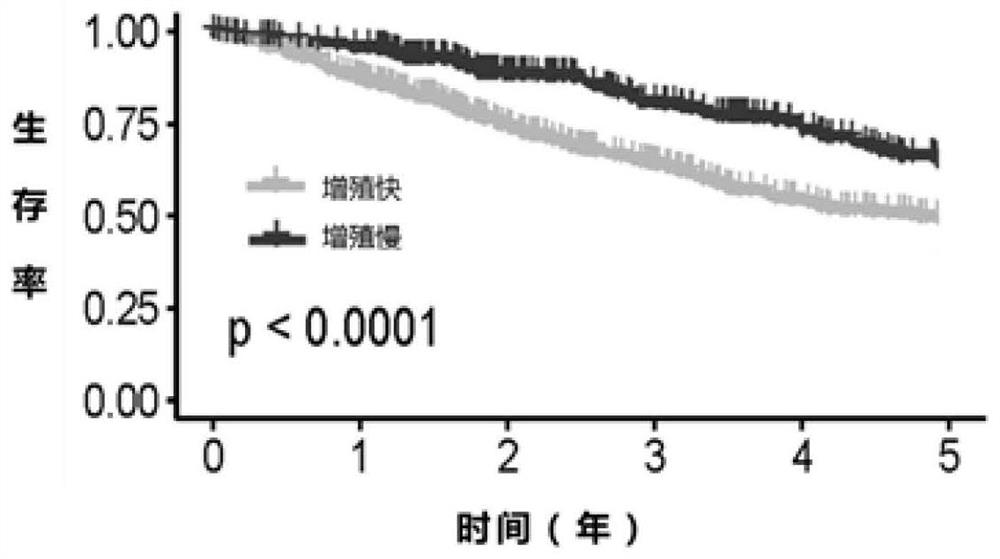Primary lung adenocarcinoma molecular typing and survival risk gene group, diagnostic product and application
A technology for molecular typing and lung adenocarcinoma, which is applied in biochemical equipment and methods, analytical materials, microbial measurement/testing, etc., can solve the problems of great differences in treatment efficiency
- Summary
- Abstract
- Description
- Claims
- Application Information
AI Technical Summary
Problems solved by technology
Method used
Image
Examples
Embodiment 1
[0123] Example 1: Evaluation of subtypes of lung adenocarcinoma and screening of survival risk-related gene groups
[0124] Methods: 504 cases in the TCGA database with complete According to the clinical information of lung adenocarcinoma gene expression, the proliferation-related genes, immune-related genes, and intercellular matrix-related genes that are closely related to the survival risk of lung adenocarcinoma are screened out, and the type and survival risk are calculated and optimized in each group of genes Genes with high contribution rate.
[0125] Results: A total of 180 genes and 6 housekeeping genes related to lung adenocarcinoma subtype and survival risk were screened, that is, 186 gene test combinations. See Table 1 for the list of genes.
[0126] The validity and stability of the 186 genes screened were verified in the Affymatrics gene chip expression profile data of 1346 cases of lung adenocarcinoma.
Embodiment 2
[0127] Example 2: Molecular typing and survival risk assessment of lung adenocarcinoma by next-generation sequencing
[0128]Experimental method: A 76-gene test combination was used, of which 70 lung adenocarcinoma subtypes and survival risk-related gene groups (proliferation-related genes: PLK1, PRC1, CCNB1, DLGAP5, KPNA2, CCNA2, RRM2, FOXM1, MKI67, KIF14, HJURP, TPX2, NEK2, CDK1, CDKN3, ASPM, CEP55, BIRC5, MELK, CDC20, TYMS, AURKA and TOP2A; immune-related genes: P2RY13, CCR2, PTPRC, IRF8, CLEC10A, TLR7, CCR4, IL7R, SPN, SASH3, CSF2RB, CD37, IKZF1, CD48, IL10RA, EVI2B, IGSF6, CD52, DOCK2, CD84, FOLR2, NCKAP1L, TRAC, MNDA, MRC1, PLEK, SPIB, CD53, CD4, and LYZ; cytoplasmic related genes: SPOCK1, COL1A1 , POSTN, ADAM12, COL6A2, COL5A1, COL11A1, COL5A2, COL1A2, MXRA5, THBS2, INHBA, VCAN, ADAMTS12, GREM1, COL3A1 and SULF1) for molecular typing and survival risk assessment, 6 internal reference genes (including GAPDH, GUSB , MRPL19, PSMC4, SF3A1 and TFRC) were used as internal st...
Embodiment 3
[0155] Example 3: Molecular classification and survival risk assessment of lung adenocarcinoma by quantitative PCR
[0156] Experimental method: A 25-gene test combination was used, of which 24 lung adenocarcinoma subtypes and survival risk-related gene groups (proliferation-related genes: PLK1, PRC1, CCNB1, MKI67, TPX2, MELK, CDC20, TYMS, and TOP2A; immune-related Genes: P2RY13, CCR2, PTPRC, IRF8, CLEC10A, TLR7, CCR4, IL7R and CD4; intercellular matrix-related genes: SPOCK1, COL1A1, POSTN, ADAM12, COL6A2 and COL5A1) for molecular typing and survival risk assessment, 1 An internal reference gene (ACTB) was used as an internal standard. All 24 genes in Table 3 except the internal reference genes were used to calculate the survival risk index.
PUM
 Login to View More
Login to View More Abstract
Description
Claims
Application Information
 Login to View More
Login to View More - R&D
- Intellectual Property
- Life Sciences
- Materials
- Tech Scout
- Unparalleled Data Quality
- Higher Quality Content
- 60% Fewer Hallucinations
Browse by: Latest US Patents, China's latest patents, Technical Efficacy Thesaurus, Application Domain, Technology Topic, Popular Technical Reports.
© 2025 PatSnap. All rights reserved.Legal|Privacy policy|Modern Slavery Act Transparency Statement|Sitemap|About US| Contact US: help@patsnap.com



